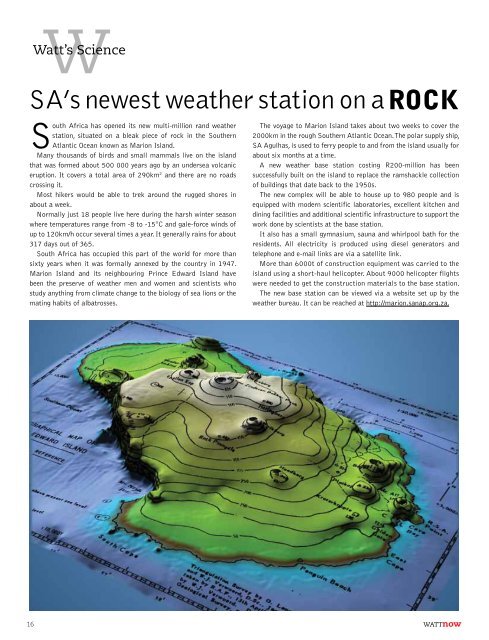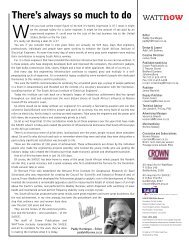download a PDF of the full March 2011 issue - Wattnow
download a PDF of the full March 2011 issue - Wattnow
download a PDF of the full March 2011 issue - Wattnow
- No tags were found...
You also want an ePaper? Increase the reach of your titles
YUMPU automatically turns print PDFs into web optimized ePapers that Google loves.
WWatt’s ScienceSA’s newest wea<strong>the</strong>r station on a rockSouth Africa has opened its new multi-million rand wea<strong>the</strong>rstation, situated on a bleak piece <strong>of</strong> rock in <strong>the</strong> Sou<strong>the</strong>rnAtlantic Ocean known as Marion Island.Many thousands <strong>of</strong> birds and small mammals live on <strong>the</strong> islandthat was formed about 500 000 years ago by an undersea volcaniceruption. It covers a total area <strong>of</strong> 290km 2 and <strong>the</strong>re are no roadscrossing it.Most hikers would be able to trek around <strong>the</strong> rugged shores inabout a week.Normally just 18 people live here during <strong>the</strong> harsh winter seasonwhere temperatures range from -8 to -15°C and gale-force winds <strong>of</strong>up to 120km/h occur several times a year. It generally rains for about317 days out <strong>of</strong> 365.South Africa has occupied this part <strong>of</strong> <strong>the</strong> world for more thansixty years when it was formally annexed by <strong>the</strong> country in 1947.Marion Island and its neighbouring Prince Edward Island havebeen <strong>the</strong> preserve <strong>of</strong> wea<strong>the</strong>r men and women and scientists whostudy anything from climate change to <strong>the</strong> biology <strong>of</strong> sea lions or <strong>the</strong>mating habits <strong>of</strong> albatrosses.The voyage to Marion Island takes about two weeks to cover <strong>the</strong>2000km in <strong>the</strong> rough Sou<strong>the</strong>rn Atlantic Ocean. The polar supply ship,SA Agulhas, is used to ferry people to and from <strong>the</strong> island usually forabout six months at a time.A new wea<strong>the</strong>r base station costing R200-million has beensuccess<strong>full</strong>y built on <strong>the</strong> island to replace <strong>the</strong> ramshackle collection<strong>of</strong> buildings that date back to <strong>the</strong> 1950s.The new complex will be able to house up to 980 people and isequipped with modern scientific laboratories, excellent kitchen anddining facilities and additional scientific infrastructure to support <strong>the</strong>work done by scientists at <strong>the</strong> base station.It also has a small gymnasium, sauna and whirlpool bath for <strong>the</strong>residents. All electricity is produced using diesel generators andtelephone and e-mail links are via a satellite link.More than 6000t <strong>of</strong> construction equipment was carried to <strong>the</strong>island using a short-haul helicopter. About 9000 helicopter flightswere needed to get <strong>the</strong> construction materials to <strong>the</strong> base station.The new base station can be viewed via a website set up by <strong>the</strong>wea<strong>the</strong>r bureau. It can be reached at http://marion.sanap.org.za.16
















